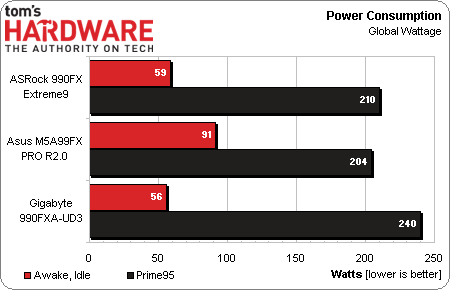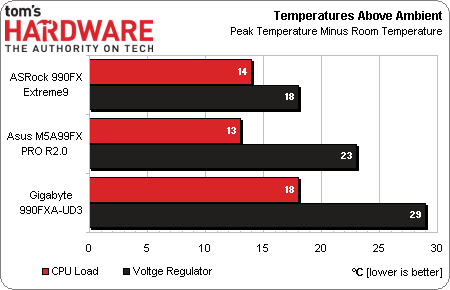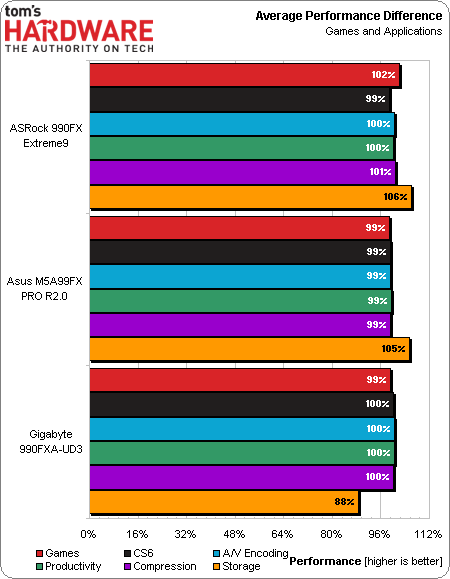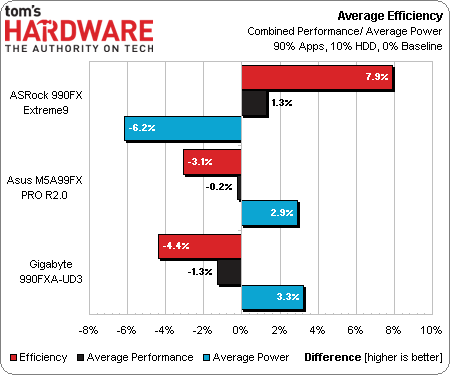Three AMD 990FX-Based Motherboards For Enthusiasts
AMD’s flagship FX-series processors squarely target enthusiasts with sub-$1,000 system budgets, and it's hard to get there with an expensive motherboard. We requested every vendor's top-value solution, and received three boards for your consideration.
Power, Heat, And Efficiency
The strangest thing about Asus’ power management software might be that, operating at its default mode, the app costs us between 25 and 30 W at idle compared to “Max Power Saving” mode or even Windows 8 running without some form of manufacturer-imposed management. Either of those options drops idle draw into the mid-60 W range. Why not switch to “Max Power Saving” mode exclusively for this test? I don't think it's realistic to expect enthusiasts to toggle between operating modes based on what they're doing. What we're testing here is a more real-world configuration.
That high idle wattage result is particularly unfortunate when we see just how much better the M5A99FX Pro R2.0 is than Gigabyte's 990FXA-UD3 at full load. Default settings appear designed to cap CPU current (and thus heat), rather than maximize performance or efficiency.
As a point of comparison, ASRock’s Intelligent Energy Saver is disabled by default.
ASRock’s multitude of tiny voltage regulator phases does a fairly good job of spreading heat across the 990FX Extreme9’s oversized heat sink.
Asus’ software plays a role in dropping the M5A99FX Pro R2.0 a percent below average, while Gigabyte’s reduced storage performance bends the ends of the curve to put ASRock 2% over the top.
More than anything, ASRock's efficiency lead is a testament to how well AMD’s hardware and firmware manages power on its own, without the intervention of software.
Get Tom's Hardware's best news and in-depth reviews, straight to your inbox.
Current page: Power, Heat, And Efficiency
Prev Page Overclocking Results Next Page Who Wins This Three-Way 990FX Comparison?-
designasaurus "if we diminished most of those power differences by not installing Asus' power management software at default settings, the company would have likely matched the performance of Gigabyte and ASRock."Reply
Don't speculate! Do the tests and add it to the article so we can see what the software packages are actually accomplishing! That's why I read your site, yeah? For hard info that I can't get myself. -
bgunner designasaurus"if we diminished most of those power differences by not installing Asus' power management software at default settings, the company would have likely matched the performance of Gigabyte and ASRock."Don't speculate! Do the tests and add it to the article so we can see what the software packages are actually accomplishing! That's why I read your site, yeah? For hard info that I can't get myself.I totally agree with this statement. The test should have been done and added into the article because this would of been a good representative of the value of the software. I would like to know for a fact if the software was a hindrance to the electrical efficiency of the Asus and Gigabye boards.Reply -
Crashman bgunnerI totally agree with this statement. The test should have been done and added into the article because this would of been a good representative of the value of the software. I would like to know for a fact if the software was a hindrance to the electrical efficiency of the Asus and Gigabye boards.At least the power was measured and mentioned, even if it didn't get into the chart.Reply
-
bit_user AMD's 890FX was an excellent low-cost server platform, in its day. Great I/O, tons of PCIe lanes, 6-channel SATA3, and ECC support. All with boards and CPUs in the desktop price range that were close to being performance competitive with Intel (when they were introduced, at least).Reply
Now, AMD is just slipping too far behind. Not just on the CPU front, but like how about some PCIe 3?
I'm waiting for 64-bit ARMs to hit the desktop. That's probably the next truly interesting thing on the horizon.
-
boulbox Reply10596062 said:Aren't the 990FX chipsets kind old?
Yes, but not a lot of new things need to be offered anyways. PCIe 3.0 is just a gimmick and doesn't really give much more performance over PCIe2 -
Crashman falchardAren't the 990FX chipsets kind old?990FX is AMD's current "high-end" chipset for enthusiast-level desktops. AMD occasionally releases new chips (look last fall) and motherboard companies keep updating their selection of products.Reply
Old chipset, recent boards, any questions?
-
darkchazz "Three AMD 990FX-Based Motherboards For Enthusiasts"Reply
I don't think enthusiasts would want to buy a slow CPU from AMD. -
Onus What did I miss? The ASRock has better features, including 3-way SLI, more USB3.0, an abundance of accessories, uses less power (the only positive efficiency), has higher performance, lower VRM temps; but BOTH of the other two got awards? I noted the comment about fluctuating prices, but on features alone ASRock looks like the winner. Surely it wasn't the slightly lower OC...Reply




